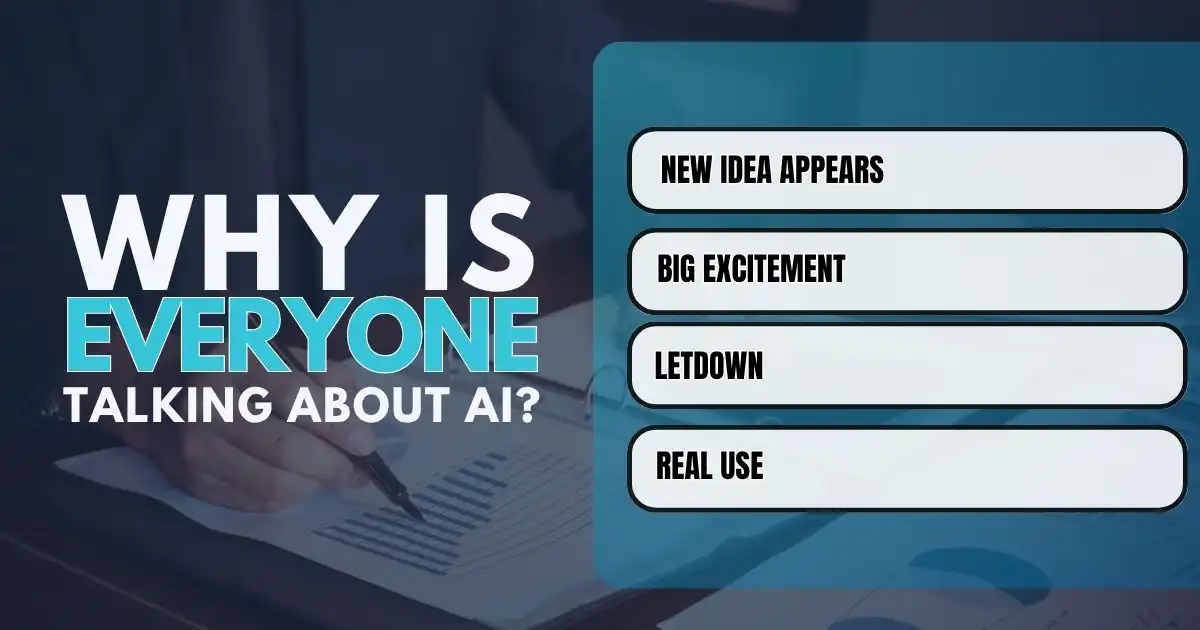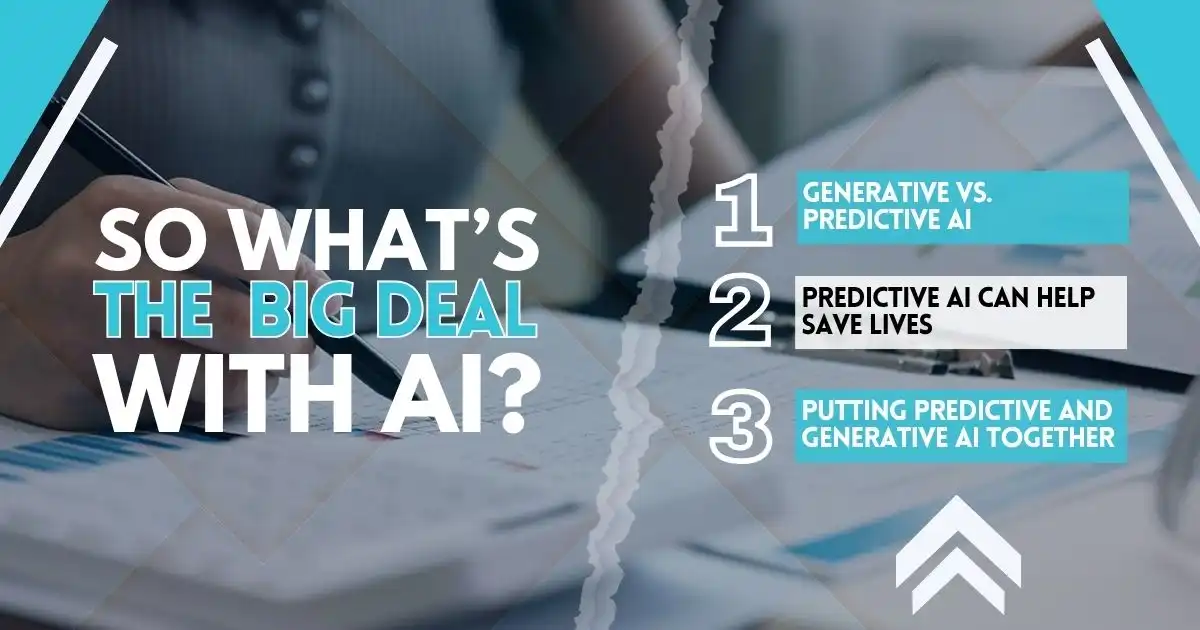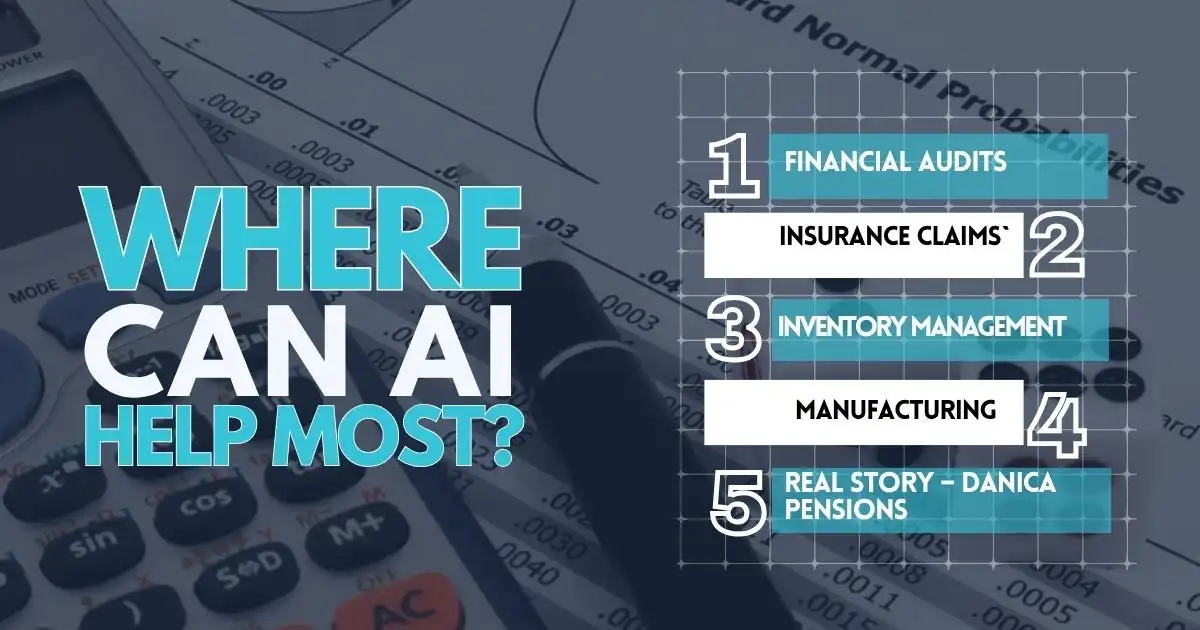AI is everywhere right now—writing headlines, powering smart devices, analyzing data, and even assisting doctors with diagnoses.
Tech giants are investing billions, startups are springing up overnight, and everyone from marketers to engineers is talking about its potential. It’s easy to feel like we’re on the edge of something huge.
But is AI truly living up to the excitement, or is the hype racing ahead of reality?
What’s All the Buzz About AI?
There’s a lot of talk about artificial intelligence (AI) these days. People are excited about what it can do—either it’s making content with generative AI or predicting the future with predictive AI.
Big tech companies and startups alike want to be part of the action. But is AI really as great as it seems? Or is the truth more complicated?
Here’s what we’ll explore:
- What a technology “hype cycle” is
- How generative AI and predictive AI work together
- How AI is changing businesses
- Where AI can help companies the most
Why Is Everyone Talking About AI?

If you’ve followed tech news for a while, you may have seen this pattern before, known as Gartner’s Hype Cycle:
- New idea appears – A fresh technology gets introduced.
- Big excitement – Everyone talks about it and expects a lot.
- Letdown – People realize it’s not perfect and get tired of it.
- Real use – Over time, the technology finds its place and becomes useful.
Right now, AI is in that “letdown” phase for some people. That’s because many AI projects didn’t work out. Common problems include unclear goals, bad data, high costs, and not showing how AI can help the business make money.
So What’s the Big Deal With AI?

AI is now part of our daily lives—whether in ads, apps, or smartwatches. Companies want to sell AI tools, sometimes just to sound trendy. But AI can actually be helpful in business.
Generative vs. Predictive AI
You’ve probably heard about generative AI—it makes things like images, text, or videos. But predictive AI is just as powerful. It looks at data and finds patterns to guess what might happen next.
Predictive AI is becoming more popular because it can deliver quick results—especially helpful when businesses are trying to save money. For example, it can help companies understand customer behavior and improve how they connect with their audience.
Predictive AI Can Help Save Lives
In healthcare, predictive AI is already helping. It’s used to find people at risk for diseases, spot early signs of outbreaks, and even assist with diagnosis and treatment plans. It does this by comparing one patient’s data with others who had similar symptoms. In some cases, this has already helped save lives.
Putting Predictive and Generative AI Together
When businesses use both types of AI, they get the best of both worlds. For instance, if a company knows a customer is likely to click on something, they can use that insight to personalize messages, prevent customer loss, and improve marketing.
In healthcare, combining these AIs can help process reports about drug side effects more quickly and accurately.
What’s Next for AI?
No one can say exactly what will happen with AI in the future. But we can make some smart guesses based on how past technologies have grown in business.
AI—especially generative AI—is helping businesses create content and automate tasks in new and clever ways. Experts like Gartner say we’ll soon see more of this through new tools like:
- Self-managing systems
- Cloud-based AI
- General AI (AGI)
- Computer vision
- Edge AI (AI on devices)
- Smart robots
- Synthetic (fake but realistic) data
Other upcoming tools like AI simulations, multi-agent systems, and “responsible AI” will help improve how AI is used in companies.
To make sure AI works well and safely, companies must set rules and controls. The data used to train AI needs to be secure, legal, accurate, and fair. Tools like SS&C Blue Prism® Enterprise AI help large businesses apply AI responsibly and with strong safety measures.
Why Is AI So Popular?
Companies that start using AI early may get a big lead over others. AI can help businesses run smoother and allow employees to focus on more valuable work.
This is known as intelligent automation (IA). It means using AI to handle boring or repetitive tasks so people can focus on being creative and strategic. AI isn’t replacing human thinking—it’s making room for more of it.
Where Can AI Help Most?

We’ve already talked about how generative AI and predictive AI help with things like customer service and health care. Here are more real-world examples:
1. Financial Audits
Audits are important but slow. AI can help auditors by checking large sets of data quickly and finding mistakes or unusual patterns, making reports more accurate and reducing risk.
2. Insurance Claims`
Insurance companies spend a lot of time handling claims. AI can speed up document reviews and help detect possible fraud, especially in first reports of loss.
3. Inventory Management
AI can watch stock levels in real time and update records automatically. Predictive AI can look at past sales and market trends to guess what customers will want next—so companies don’t run out of products or overstock.
4. Manufacturing
When factories add sensors and connect machines to the internet (IoT), AI can track equipment health. It can also predict when machines might break down so workers can fix them before problems happen.
5. Real Story – Danica Pensions
A company called Danica Pensions used generative AI to support their digital workforce. Now, 80% of their staff have a digital helper to assist with daily tasks.
So… Is AI All Just Hype?
That depends. AI can bring big changes to work—but only if used the right way for the right reasons.
For example:
- A telecom company might use AI chatbots to reduce customer call wait times.
- A bank might use AI to spot fraud earlier.
AI will change the future of work—what we do, how we do it, and who (AI or humans) does what. Businesses that plan wisely and apply AI with strong rules will see real success.
If you’re ready to move forward, start by:
- Looking at real examples that work
- Managing the risks with strong governance
- Planning how AI fits with your business and people
AI Isn’t Just Hype—It’s a Wake-Up Call
The question isn’t whether AI is overhyped—it’s whether you’re ready to meet the moment. While the spotlight often shines on futuristic promises, the real power of AI is already quietly improving how businesses operate, from streamlining audits to saving lives in hospitals.
The tools exist. The use cases are proven. What’s missing in many cases isn’t the technology—it’s the strategy.
The future of work isn’t about humans versus machines. It’s about how well we combine human intelligence with machine efficiency. Businesses that succeed won’t be the ones with the flashiest AI demos, but those who deploy AI with purpose, responsibility, and people in mind.
AI is no longer a distant concept—it’s your next business advantage. Use it wisely, and you won’t just ride the wave of innovation—you’ll help shape it.
FAQs
Is AI hype or reality in today’s business world?
AI is both hype and reality—while some tools are overpromised, many are delivering real value in areas like automation and analytics. The key is focusing on proven, ROI-driven use cases.
Why do some people say artificial intelligence is losing hype?
AI hype is fading for some because early expectations weren’t met due to poor planning and execution. This shift signals a move toward more practical, results-driven adoption.
Are AI tools hype or actually useful?
Some AI tools live up to the hype and improve efficiency, while others fall short of their promises. Choosing the right tool depends on real business needs and clear use cases.
What causes the rise and fall of AI hype cycles?
AI hype cycles happen when excitement outpaces results, then settle as the tech matures and proves its worth. Understanding this helps businesses adopt AI more wisely.
